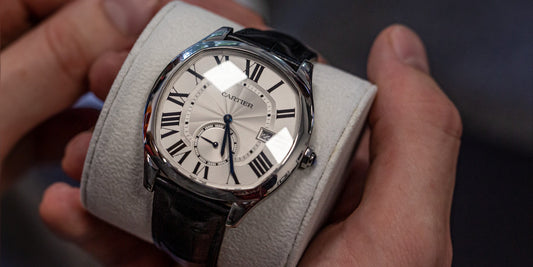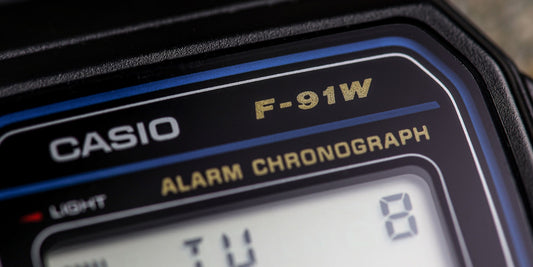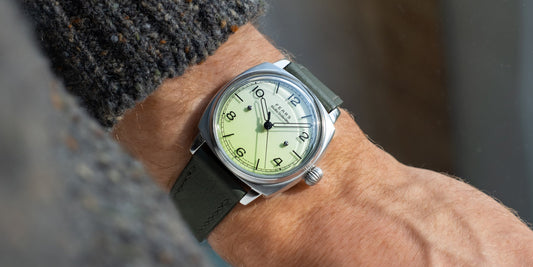I’ve been fortunate to spend many months of my life in the quiet corner of Saxony known for its incredible watchmaking output. Glashütte, a quaint town of barely 5,000 inhabitants sits about half an hour’s drive from Dresden, the state’s capital. It exists in stark contrast to Saxony’s biggest urban centres, with both Dresden and Leipzig often stealing the limelight from this often-ignored settlement that has, for the past 179 years, gone about the business of creating some of the world’s finest watches quietly.

Mühle Glashütte 29er in Mint and Apricot. Credit: Mühle Glashütte.
Despite this typically humble approach to the craft, Glashütte’s list of achievements is long. It is home to ten thriving watch companies, addressing all tiers of watchmaking’s pricing hierarchy. The undisputed jewel in the crown of the town is the Richmont-owned A. Lange & Söhne, a company whose original founder was the man who brought watchmaking to the area, but to think the story begins and ends with Lange would be a mistake for anyone keen to unearth the hidden treasures of our industry to avoid making.
When it comes to more accessible price brackets, the names of NOMOS Glashütte and Tutima might spring to mind. But just one kilometre down the road from the factories of both, one of the oldest family-owned companies in the area is producing a swathe of interesting timepieces that sorely deserve more attention.
 Mühle Glashütte Sportivo. Credit: WatchGecko.
Mühle Glashütte Sportivo. Credit: WatchGecko.
Mühle Glashütte made its name as a producer of nautical instruments. So important is that phase of the company’s history, it still adorns the brand’s wordmark, arched above the family name and its location, reminding us all of this quirky little maker’s heritage.
While “Nautische Instrumente” isn’t the most obscure translation you’re likely to find in Germany, it is possible its meaning and significance have escaped some followers of the brand. However, its meaning, not just in words but in mission, should not be underestimated. Although the brand seldom makes clocks for the great nautical vessels whose walls they once adorned, Mühle Glashütte retains some ties to the maritime industry that run deep. That heritage is on full display in the brand’s current collection, with highly legible, accurate, and wearable watches designed for purpose proliferating the catalogue’s pages.

Mühle Glashütte HQ. Credit: WatchGecko.
Perhaps the most famous of the bunch is the distinctive S.A.R. Mission-Timer, which looks like little else on the market. It’s a weird, bubble of a watch, with hooded lugs that meet a rubber strap as standard but are actually capable of carrying any one or two-piece strap of the correct width. While the watch may lose some of its character when worn on anything other than the supplied rubber strap (which adds significant presence to it on the wrist), or the bund strap that was used in the past on a special edition of the line, its unusualness cannot be denied, whatever band you choose to wear it on.
Bold hour markers — four massive triangles — adorn the dial. Although enormous by any standard, these indexes have been considerately designed to not impede the minute track. While it may sound basic, not a single minute marker is omitted on this dial, with the bases of the triangles at 3, 6, and 9 perfectly integrated with the seconds track around the outside of the dial. For example, the minute markers for 14, 15, and 16 minutes are lovingly notched out of the triangle at 3 o’clock. Similarly, the minute markers for 29, 30, and 31 can be found in the 6 o’clock triangle, and 44, 45, and 46 are nestled in the 9 o’clock wedge.

Mühle Glashütte Sportivo Trio. Credit: Mühle Glashütte.
At 12, the consideration continues but shifts to a different style to help with orientation. Instead of the triangle’s base playing home to the three markers that would otherwise have been omitted, the tip of the upward-pointed triangle marks twelve, and that tip is flanked on either side by small, circular dots representing the 59 and 01 minute markers.

Mühle-Glashütte Seebataillon GMT. Credit: Guest Author.
It may be a small thing over which to obsess, but it is in the little things that a brand’s true intentions can be observed. Mühle does not make much noise. Despite possessing one of the most intriguing and unbroken lineages of CEOs in the German watchmaking scene — something which is often a muddled mess thanks to the GDR period that saw all companies consumed by a massive, state-operated conglomerate known as the GUB (Glashütte Uhren Betrieb) — Mühle is content to ply its trade in peace, choosing instead to let the watches speak to those who care to do their research.
This is all well and good, and a strategy that has seen Mühle continue to grow steadily since the Berlin Wall came down and returned the company to the private ownership of the Mühle family, but as someone who reads self-aggrandising press releases from have-a-go brands aplenty on a near daily basis, forgive me for feeling like more attention should be paid to a company that does its own thing the right way.




Hands-on time with Mühle Glashütte models. Credit: WatchGecko.
Mühle does not make all of its movement components in-house, but it makes so many of them, that some of the calibres that began life as Sellita base movements, have been given their very own movement number. This is not an uncommon practice when brands make significant changes to the aesthetics or operation of a bought-in calibre, but the bar is often set much lower than Mühle sets its own. This is at the brand’s discretion (surprisingly, there isn’t a hard and fast rule for when a modified bought-in calibre becomes something entirely different), but it speaks once more to the company’s philosophy.

Mühle Glashütte Teutonia II GMT. Credit: Mühle Glashütte.
Do it slowly and do it right. Make watches that honour the brand’s long history and prepare it for an even longer future. Mühle may not be the biggest name in Glashütte. It may not produce the most watches. But it has a heart and a heritage that some other brands in the region could learn a thing or two from.
I’ve always had a soft spot for the S.A.R. Flieger Chronograph and the Seebataillon GMT models, but I never pulled the trigger. After visiting the brand and seeing a workforce willing to get its hands dirty actually making components that will end up on wrists, my reasons to dally have dwindled. I expect that very soon I’ll be adding a watch from this maker to my collection and likely boring my peers to death about how they should too. Watch this space.
















